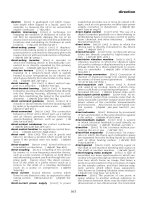Cutting Tools Episode 1 Part 9 pps
Bạn đang xem bản rút gọn của tài liệu. Xem và tải ngay bản đầy đủ của tài liệu tại đây (884.19 KB, 9 trang )
Cutting
Tool
Applications
Cutting Tool Applications
By George Schneider, Jr. CMfgE
www.toolingandproduction.com
Chapter 9/Tooling & Production
1
9.1 Introduction
One of the most important and essential tools in any metalworking shop is the drilling
machine or drill press. Although the drilling machine is used primarily for drilling holes,
it is often used for reaming, boring, tapping, counterboring, countersinking, and spotfac-
ing.
All drilling machines operate on the same basic principle. The spindle turns the cut-
ting tool, which is advanced either by hand or automatically into a workpiece that is
mounted on the table or held in a drill press vise. Successful operation of any drilling
machine requires a good knowledge of the machine, proper set-up of the work, correct
speed and feed, and proper use of cutting fluids applied to the cutting tool and work.
9.2 Types of Drill Presses
Many types and sizes of drilling machines are used in manufacturing. They range in size
from a simple bench mounted sensitive drill press to the large multiple-spindle machines
able to drive many drills at the same time.
Figure 9.1 shows a schematic diagram of a standard vertical drill press as well as a
schematic diagram of a turret-drilling machine. Described below are these and other
types of drill presses such as sensitive and radial drills.
Chapter 9
Drilling Methods
& Machines
Upcoming Chapters
Metal Removal
Cutting-Tool Materials
Metal Removal Methods
Machinability of Metals
Single Point Machining
Turning Tools and Operations
Turning Methods and Machines
Grooving and Threading
Shaping and Planing
Hole Making Processes
Drills and Drilling Operations
Drilling Methods and Machines
Boring Operations and Machines
Reaming and Tapping
Multi Point Machining
Milling Cutters and Operations
Milling Methods and Machines
Broaches and Broaching
Saws and Sawing
Abrasive Processes
Grinding Wheels and Operations
Grinding Methods and Machines
Lapping and Honing
George Schneider, Jr.CMfgE
Professor Emeritus
Engineering Technology
Lawrence Technological University
Former Chairman
Detroit Chapter ONE
Society of Manufacturing Engineers
Former President
International Excutive Board
Society of Carbide & Tool Engineers
Lawrence Tech.Univ.:
Prentice Hall:
FIGURE 9.1: Schematic illustration of (a) vertical drill press,
(b) CNC turret drilling machine.
(a)
Fixed head
(power head)
Spindle
Adjustable head
Spindle
Chuck
Table
Base
(b)
Column
Turret
Base
Table
Column
Hand
wheel
Chap. 9: Drilling Methods & Machines
2
Tooling & Production/Chapter 9
www.toolingandproduction.com
9.2.1 Simple Drill Press
A simple drill press (Fig.9.2) may be
floor mounted as shown, or have a
shorter main post and be mounted on a
bench. The motions of this machine are
very simple. The table on a floor model
can be raised or lowered and rotated
around the machine column. The spin-
dle rotates and can be raised and low-
ered, with a stroke of 4 to 8 inches.
Stops can be set to limit and regulate the
depth.
9.2.2 Sensitive Drill Press
The name ‘sensitive’ is used to indicate
that the feed is hand operated and that
the spindle and drilling head are coun-
terbalanced so that the operator can
‘feel’ the pressure needed for efficient
cutting. A table mounted sensitive drill
press is shown in Figure 9.3.
The drill press has the same motions
as the previous one plus a telescoping
screw for raising and lowering the table
and a sliding ‘drill head’. These two
features allow easier handling of parts
of varying heights.
9.2.3 Radial Drill
For handling medium to very large size
castings, weldments, or forgings, radial
drills are ideal. The length of the arm
along which the spindle housing rides
specifies their size. This arm can be
from 3 to 12 feet long. The column that
holds the arm may be from 10 to 30
inches in diameter. A radial drill is
shown in Figure 9.4.
For very large work, the arm may be
rotated 180 degrees and work placed on
the shop floor. Speeds and feeds are
dialed in by the machine operator and
are the same as for other drill presses.
Drilling is either hand or power feed.
9.3 Drilling Machine Components
Rigid and accurate construction of
drilling machines is important to obtain
proper results with the various cutting
tools used. The sensitive drilling
machine construction features are dis-
cussed in this section because its fea-
tures are common to most other drilling
machines.
Base: The base is the main support-
ing member of the machine. It is heavy
gray iron or ductile iron casting with
slots to support and hold work that is
too large for the table
Column: The round column may be
made of gray cast iron or ductile iron for
larger machines, or steel tubing for
smaller bench drill presses. It supports
the table and the head of the drilling
machine. The outer surface is machined
to function as a precision way of align-
ing the spindle with the table.
Table: The table can be adjusted up
or down the column to the proper
height. It can also be swiveled around
the column to the desired working posi-
tion. Most worktables have slots and
holes for mounting vises and other
work-holding accessories. Some tables
are semi universal, meaning that they
can be swiveled about the horizontal
axis.
Head: The head houses the spindle,
quill, pulleys, motor, and feed mecha-
nism. The V-belt from the motor drives
a pulley in the front part of the head,
which in turn drives the spindle. The
spindle turns the drill. Two head assem-
blies are shown in Figure 9.2 b and c.
Speeds on a stepped V pulley drive are
changed by changing the position of the
V-belt (Fig. 9.2b) Speeds on a variable-
speed drive mechanism are changed by
a hand wheel on the head. (Fig. 9.2c)
The spindle must be revolving when
this is done.
Quill assembly: The spindle rotates
within the Quill (Fig. 9.5) on bearings.
FIGURE 9.2: a) a sensitive drill press is used for drilling holes; b) speeds on a stepped V
pulley drive are changed by hanging the position of the V belt; c) speeds on a variable-
speed drive mechanism are changed by the handwheel on the head. (Courtesy Clausing
Industries, Inc.)
FIGURE 9.3: A table mounted sensitive
drill used for drilling small holes.
(Courtesy Clausing Industries, Inc.)
Chap. 9: Drilling Methods & Machines
www.toolingandproduction.com
Chapter 9/Tooling & Production
3
The quill moves vertically by means of
a rack and pinion. The quill assembly
makes it possible to feed or withdraw
the cutting tool from the work. Located
on the lower end of the spindle is either
a Morse tapered hole or a threaded stub
where the drill chuck is mounted. For
drilling larger holes, the drill chuck is
removed and Morse tapered cutting
tools are mounted.
Size Classification: The size (capac-
ity) of a drilling machine is determined
by all the following features:
• Twice the distance from the center of
the spindle to the inner
face of the column
• The maximum length
of quill travel
• The size of the Morse
taper in the spindle
• The horsepower of the
motor.
9.4 Drilling Systems
Drilling systems are
usually automated and
computer controlled.
Speeds, feeds, and
depth of cut are often
pre-set. Such systems
combine drilling opera-
tions with reaming, tap-
ping, countersinking, etc.
Figure 9.6 shows a 3-axis
CNC drilling machine.
9.4.1 Multi Spindle
Drilling
This type of drilling can be done on drill
presses by using special attachments.
The spindle locations are adjustable,
and the number of spindles may be from
two to eight. Drills, reamers, counter-
sinks, etc., can be used in the spindles.
The RPM and feed rate of all spindles in
one drill head are the same, and the
horsepower needed is the sum of the
power for all cutting tools used. In this
type of machine, a large number of
holes may be drilled at one time.
Several different diameters of drills may
be used at the same time.
9.4.2 Gang Drilling
An economical way to perform several
different operations on one piece is by
gang drilling as shown in Figure 9.7.
This might include drilling two or more
sizes of holes, reaming, tapping, and
countersinking. The work is held in a
vise or special fixture and is easily
moved along the steel table from one
spindle to the next.
The drill presses usually run continu-
ously so the operator merely lowers
each spindle to its preset stop to perform
the required machining operation.
9.4.3 Turret Drill
Turret drills (Fig. 9.1b) with either six
or eight spindles enable the operator to
use a wide variety of cutters and yet
move the workpiece
only a few inches,
according to the hole
spacing. The turret can
be rotated (indexed) in
either direction, and
then lowered, by hand
or automatically, to
make the cut.
Some turret drills
have automatic,
hydraulically con-
trolled spindles.
Speeds, feeds, and
depths of cut can be
preset for fast produc-
tion. Figure 9.1b
shows an automatic
machine. These
machines are also made
with the entire opera-
tion computer con-
trolled, (CNC turret
FIGURE 9.4: Radial drills are used to machine large cast-
ings, weldments or forgings. (Courtesy Summit Machine
Tool Manufacturing Corp.)
FIGURE 9.7: Gang drilling machines permit
economical ways to perform several different
operations. (Courtesy Clausing Industries,
Inc.)
FIGURE 9.6: Shown is a 3-axis CNC drilling
Machine (Courtesy: TechniDrill Systems, Inc.)
FIGURE 9.5: The spindle rotates within the quill.
The quill moves vertically by means of a rack and
pinion. (Courtesy: Clausing Industries, Inc.)
Chap. 9: Drilling Methods & Machines
4
Tooling & Production/Chapter 9
www.toolingandproduction.com
drill), so that the operator merely has to
load and unload the parts. A numerical-
ly controlled turret drill is shown in
Figure 9.8.
9.5 Operation Set-up
In drilling operations the three most com-
mon work holding methods are:
• Vises
• Angle Plate
• Drill Jigs
Vises: Vises are widely used for
holding work of regular size and shape,
such as flat, square, and rectangular
pieces. Parallels are generally used to
support the work and protect the vise
from being drilled. Figure 9.9 shows a
typical vise. Vises should be clamped to
the table of the drill press to prevent
them from spinning during operation.
Angular vises tilt the workpiece and
provide a means of drilling a hole at an
angle without tilting the table. An angu-
lar vise is shown in Figure 9.10.
Angle Plates: An angle plate sup-
ports work on its edge. Angle plates
accurately align
the work perpen-
dicular to the
table surface, and
they generally
have holes and
slots to permit
clamping to the
table and holding
of the workpiece.
Drill Jigs: A
drill jig is a pro-
duction tool used
when a hole, or
several holes,
must be drilled in
a large number of
identical parts.
Figure 9.11 shows
a diagram of a typical drill jig. The drill
jig has several functions. First, it is a
work holding device, clamping the work
firmly. Second, it locates work in the cor-
rect position for drilling. The third func-
tion of the drill jig is to guide the drill
straight into the work. This is accom-
plished by use of drill bushings.
9.5.1 Tool Holding Devices
Some cutting tools used in drilling
can be held directly in the spindle
hole of the machine. Others must
be held with a drill chuck, collet,
sleeve, socket, or one of the many
tool-holding devices shown in
Figure 9.12.
Drill Chucks: Cutting tools with
straight shanks are generally held in
a drill chuck. The most common
drill chuck uses a key to lock the
cutting tool. Drill chucks, both with key
and keyless, are shown in Figures 9.13.
Sleeves: Cutting tools with tapered
shanks are available in many different
sizes. When a cutting tool that has a
smaller taper than the spindle taper
used, a sleeve must be fitted to the
shank of the cutting tool.
Sockets: If the cutting tool has a
tapered shank larger than the spindle
taper, a socket is used to reduce it to the
correct size. Figure 9.14 shows various
size keyless drill chucks with one
straight and two tapered shank mount-
ings.
9.6 Deep-hole Drilling
The term ‘deep holes’ originally
referred to hole depths of over 5 x the
diameter. Today, deep-hole drilling is a
collective name for methods for the
FIGURE 9.9: Vises should be clamped to the
table of drill presses to prevent them from spin-
ning. (Courtesy Kurt Manufacturing Co.)
FIGURE 9.11: Drill jigs locate and clamp workpieces, and guide the
drill through a drill bushing.
FIGURE 9.10: The angle vise tilts the workpiece and pro-
vides a means of drilling a hole at an angle. (Courtesy:
Palmgren Steel Products, Inc.)
FIGURE 9.8: Numerically controlled turret drill automatically
positions the worktable. (Courtesy: Kanematsu USA, Inc.)
Drill bushings
Thumb screw
Locating pins
Bottom View
Workpiece
Chap. 9: Drilling Methods & Machines
www.toolingandproduction.com
Chapter 9/Tooling & Production
5
machining of both short and deep holes.
Deep-hole drilling is the preferred
method for drilling hole depths of more
than 10 x the diameter, but because of
the method’s high metal-removal capac-
ity and precision, it is also
competitive for small
holes down to 2 x the
diameter.
During drilling, it is
important that the chips
be broken and that they
can be transported away
without jamming and
affecting the drilled sur-
face. In deep-hole
drilling, cutting fluid sup-
ply and chip transport
have been provided for by
the development of three
different systems that per-
mit trouble-free machin-
ing of hole depths of
more than 100 x the
diameter. The three sys-
tems are called: the Gun
Drilling System, the
Ejector System (two-tube system) and
the Single Tube System (STS).
Some of the tools used in deep-hole
drilling are shown in Figure 9.15.
Hyper Tool manufactured the gun drills,
and Sandvik manufactured the index-
able tools.
9.6.1 Gun Drilling Systems
The gun drill system uses the oldest
principle for cutting fluid supply. The
cutting fluid is supplied through a duct
inside the drill and delivers coolant to
the cutting edge, after which it removes
the chips through a V-shaped chip flute
along the outside of the drill. Due to the
V-groove, the cross section of the tube
occupies 3/4 of its circumference.
Figure 9.16 shows a gun drilling system
and its component parts.
Gun Drills
Gun drills belong to the pressurized
coolant family of hole making tools.
They are outstanding for fast, precision
machining regardless of hole depth. As
a rule, a gun drill can hold hole straight-
ness within 0.001 inch per inch (IPI) of
penetration, even when the tool is rea-
sonably dull. For most jobs a gun drill
can be used to cut from 500 to 1000
inches in alloy steel before re-sharpen-
ing is necessary. In aluminum, it might
be 15,000 inches, while in cast iron it is
usually around 2000 inches. Figure
9.17a shows a gun drilling tool and
Figure 9.17b shows the gun drilling
process.
Depending on the tool’s diameter, a
gun drill is seldom run at feed rates
exceeding 0.003 inches per revolution
(IPR). This is extremely light compared
to twist drill feeds, which typically
range from 0.005 IPR to 0.010 IPR. But
gun drilling does use a relatively high
FIGURE 9.12: Various tool-holding devices such as
chucks, collets, sleeves, and sockets are shown. (Courtesy
Lyndex Corp.)
FIGURE 9.13: Key and keyless chucks
are used to hold drills for holemaking
operations. (Courtesy Bridgeport Machine,
Inc.)
FIGURE 9.14: Various size drill chucks
are shown. (Courtesy: Royal Products)
FIGURE 9.15: Deep-hole drilling tools;
the gun drills were manufactured by
Hyper Tool and the indexable tools were
manufactured by Sandvik. (Courtesy
TechniDrill Systems, Inc.)
FIGURE 9.16: Schematic diagram of a gun drilling system with major components.
(Courtesy Sandvik Coromant Co.)
Chap. 9: Drilling Methods & Machines
6
Tooling & Production/Chapter 9
www.toolingandproduction.com
speed compared to high speed steel
(HSS) twist drilling. This accounts for
the high metal-removal rates associated
with the process. In aluminum, speeds
may be 600 surface feet per minute
(SFPM), in steels from 400 SFPM to
450 SFPM.
Speeds and feeds for gun drilling are
based on the workpiece material and
shop floor conditions. Published charts
only provide starting points. On-the-
floor experimentation is critical to
determine the right combination for
maximum tool life.
Gun Drill Body
The body of a gun drill is typically
constructed from 4120 aircraft quality
steel tubing that is heat treated to
between 35 to 40 Rc. A 4140 steel dri-
ver is brazed to one end of the tube and
a carbide tool tip is brazed to the other
end. Figure 9.18 shows five different
tool tip geometries with various coolant
hole placements.
There are two body styles for multi-
ple flute tools; milled and crimped. The
former is a thick wall tubular shaft with
the flutes milled into the body. The lat-
ter is a thin wall tubular shaft that has
the flutes swaged into it. The number of
flutes depends on the material being cut.
When drilling in a material that breaks
easily into small chips, such as cast iron,
a two flute tool is the choice. On the
other hand, for a material such as D2
tool steel, a single flute design is pre-
ferred. In this case, chips tend to be
stringy and a single flute tool will mini-
mize the chance of jamming as they are
removed from the hole.
Figure 9.19 shows both a crimp style
gun drill body with two flutes produced
by swaging and a conventional milled
style gun drill. The coolant holes in the
crimped body have an irregular shape
that permits carrying a much larger vol-
ume of coolant than comparable holes
in a conventional equivalent diameter
tool body. Also, the flutes that are
formed are much deeper than milled
tools because allowance does not have
to be made for wall thickness between
flute and coolant hole. These deeper
flutes improve the chip removal effi-
ciency of the tool.
Gun Drill Tip
A conventional gun drill has a hole in
its carbide tip underneath the cutting
edge. Pressurized cutting
fluid is pumped through the
tool’s body and out the hole
(see Figure 9.18). The
fluid serves a three-fold
purpose: it lubricates and
cools the cutting edge; it
forces the chips back along
the flute in the tool body;
and it helps to stiffen the
shank of the tool.
A new design has one
hole in the top of the tool
tip that effectively directs
fluid at the cutting edge. The other hole
that is in the conventional location helps
to provide the chip ejection function.
Total flow of cutting fluid is doubled
with this two-hole arrangement. More
importantly, the design produces chips
about half the size of a conventional gun
drill of the same diameter using the
same speed and feed rate, so that pack-
ing of chips along the tool’s shank is
avoided in most materials.
The most common tool tip material is
C2 carbide, which is one of the harder
grades and is generally associated with
cast iron applications. Because exces-
sive tool wear is a major problem when
cutting steel, a hard grade such as C2 is
recommended, even though C5 carbide
is labeled as the steel machining grade
in most text books. C5 carbide is a
shock resistant grade, not a wear-resis-
tant grade, so that it is not as suitable for
a gun drill tool tip. C3 carbide is hard-
er than C2, and is used for certain appli-
cations; however, greater care must be
taken when re-sharpening this material
because it is easier to heat check the cut-
ting edge.
Recently, coatings such as titanium
nitride are being applied to gun drill tips
to extend tool life. Physical Vapor
Deposition (PVD) is the only practical
process for depositing coatings on pre-
cision tools such as gun drills, but the
results have not been encouraging.
Unlike coating high-speed steel tools,
PVD coating of a carbide gun drill tip
does not seem to form a good metallur-
gical bond. The coating wipes off dur-
ing the metal cutting process. Using
Chemical Vapor Deposition (CVD) will
form a metallurgical bond between the
coating and carbide substrate, but the
high heat required by the process dis-
torts the tool. Hopefully these problems
will be resolved in the near future.
(b)
FIGURE 9.17: (a) Gun drilling head. (b) A drawing of a gun drilling process. (Courtesy Star Cutter
Co.)
FIGURE 9.18: Shown are five different tool tip geometries with various coolant
hole placements (Courtesy: Star Cutter Co.)
(a)
Chap. 9: Drilling Methods & Machines
www.toolingandproduction.com
Chapter 9/Tooling & Production
7
9.6.2 The Ejector System
The Ejector System consists of drill
head, outer tube, inner tube, connector,
collet and sealing sleeve. The drill head
is screwed to the drill tube by means of
a four-start square thread. The inner
tube is longer than the outer tube. The
drill tube and the inner tube are attached
to the connector by means of a collet
and a sealing sleeve. The collet and
sealing sleeve must be changed for dif-
ferent diameter ranges. Figure 9.20
shows the Ejector System and its com-
ponents.
9.6.3 The Single Tube System (STS)
The Single Tube System is based on
external cutting fluid supply and inter-
nal chip transport. As a rule, the drill
head is screwed onto the drill tube. The
cutting fluid is supplied via the space
between the drill tube and the drilled
hole. The cutting fluid is then removed
along with the chips through the drill
tube. The velocity of the cutting fluid is
so high that chip transport takes place
through the tube without disturbances.
Since chip evacuation is internal, no
chip flute is required in the shank, so tip
cross-section can be made completely
round, which provides much higher
rigidity than the gun drill system.
Figure 9.21 shows the Single Tube
System and its components.
9.6.4 Comparison of STS
and Ejector Systems
Both the Single Tube System and the
Ejector System have wide ranges of
application, but there are times when
one system is preferable to the other.
STS is preferable in materials with
poor chip formation properties such as
stainless steel, low carbon steel, and
materials with an uneven structure,
when chip breaking problems exist.
STS is also more advantageous for long
production runs, uniform and extremely
long workpieces and for hole diameters
greater than 7.875 inches.
The Ejector System requires no seal
between the workpiece and the drill
bushing. The system can therefore be
adapted easily to existing machines and
is preferable in NC lathes, turning cen-
ters, universal machines and machining
centers. Since the cutting fluid is sup-
plied between the outer and inner tubes,
no space is required between the drill
tube and the hole wall as in the case of
STS drilling. The Ejector System is
therefore often used for machining in
workpieces where sealing problems can
arise. The Ejector System can be used
to advantage when it is possible to use a
predrilled hole instead of a drill bushing
for guidance, for example in machining
centers.
9.6.5 Operational Requirements
Machining with high cutting speeds and
high demands on surface finishes and
tolerances requires a machine tool that
is both very rigid and very powerful. It
is possible to use conventional
machines with sufficient power and
rigidity.
Machine Requirements: The high
Milled-Style Bullnose Grind
Double-Crimp Fishtail Grind
FIGURE 9.21: The single-tube system (STS) and its major components. (Courtesy
Sandvik Coromant Co.)
FIGURE 9.20: The ejector system and its major components. (Courtesy Sandvik
Coromant Co.)
FIGURE 9.19: There are two body styles of multifluted gun drills: milled style and dou-
ble-crimp style.
Chap. 9: Drilling Methods & Machines
8
Tooling & Production/Chapter 9
www.toolingandproduction.com
feed speeds that
characterize deep
hole drilling
impose high
demands on avail-
able power. In
order to achieve
good precision, the
machine must be
rigid and the spin-
dle bearings free of
play. Good chip
breaking often
requires high feed
and the feed must
be constant, other-
wise the chip
breaking may vary,
leading to chip
jamming. The best
possible chip
breaking can be
obtained with infinitely adjustable feed.
It is important that the machine be
equipped with safety devices to protect
the machine, the tool and the workpiece.
The purpose of the safety device is to
stop the machine automatically in the
event of overloading. The machine
spindle should not be able to start until
the pressure of the cutting fluid has
reached a preset minimum. The tem-
perature and quantity of the cutting fluid
should also reach a correct level before
the machine starts.
Best are overload protections that are
connected to the feed pressure. It is
extremely important that the overload
limits be set no more than 10 - 13 per-
cent above the actual drill pressure for
each drill diameter and feed. The feed
will then be able to stop before the drill
is damaged.
Machine Types: The design of deep
hole drilling machines varies. The
lengths of the machines are adapted to
the special diameter ranges and lengths
of the workpiece. A special very long
machine is shown in Figure 9.22
Deep hole drilling machines are often
designed to permit a choice between a
rotating workpiece, a rotating tool or
both rotating workpiece and rotating
tool. In the machining of asymmetric
workpieces, the machine works with a
rotating drill and a non-rotating work-
piece, since the workpiece cannot rotate
at sufficient speed. In the machining of
long, slender workpieces, a non-rotating
drill is fed into a rotating workpiece.
When the hole must meet high straight-
ness requirements, both the drill and the
workpiece rotate. The direction of rota-
tion of the drill is then opposite to that
of the workpiece.
The Single Tube System is difficult to
adapt to standard machines, while
Ejector drilling and, in some cases, gun
drilling, can be done relatively simply
in conventional machines. The largest
extra costs are then for the cutting fluid
system, chip removal arrangement, fil-
ter tank and pump. Figure 9.23 shows a
special gun-drilling machine to drill six
camshafts simultaneously. This
machine includes auto loading and
unloading of parts.
Chip Breaking: Of primary impor-
tance in drilling operations is transport-
ing the chips away from the cutting
edges of the drill. Excessively long and
large chips can get stuck in the chip
ducts. A suitable chip is as long as it is
wide. However, the chips should not be
broken harder than necessary, since chip
breaking is power consuming and the
heat that is generated increases wear on
the cutting edges. Chips with a length 3
- 4 times their width can be acceptable,
provided that they can pass through the
chip duct and drill tube without difficul-
ties. Chip formation is affected by the
work material, chip breaker geometry,
cutting speed, feed and choice of cutting
fluid.
Coolant System: The purposes of
the coolant in a drilling system are:
• Support and lubrication of the pads
• Improvement of the tool life
• Dissipation of heat
• Flushing of chips
The coolant system has to provide an
adequate supply of clean coolant to the
tool at the correct pressure and temper-
ature.
FIGURE 9.22: The length of a deep-hole drilling machine
depends on the diameter and the length of the workpiece.
(Courtesy Sandvik Coromant Co.)
FIGURE 9.23: Special gun drilling machine is shown drilling six camshafts simultane-
ously. This machine includes automatic loading and unloading of parts. (Courtesy
TechniDrill Systems, Inc.)









